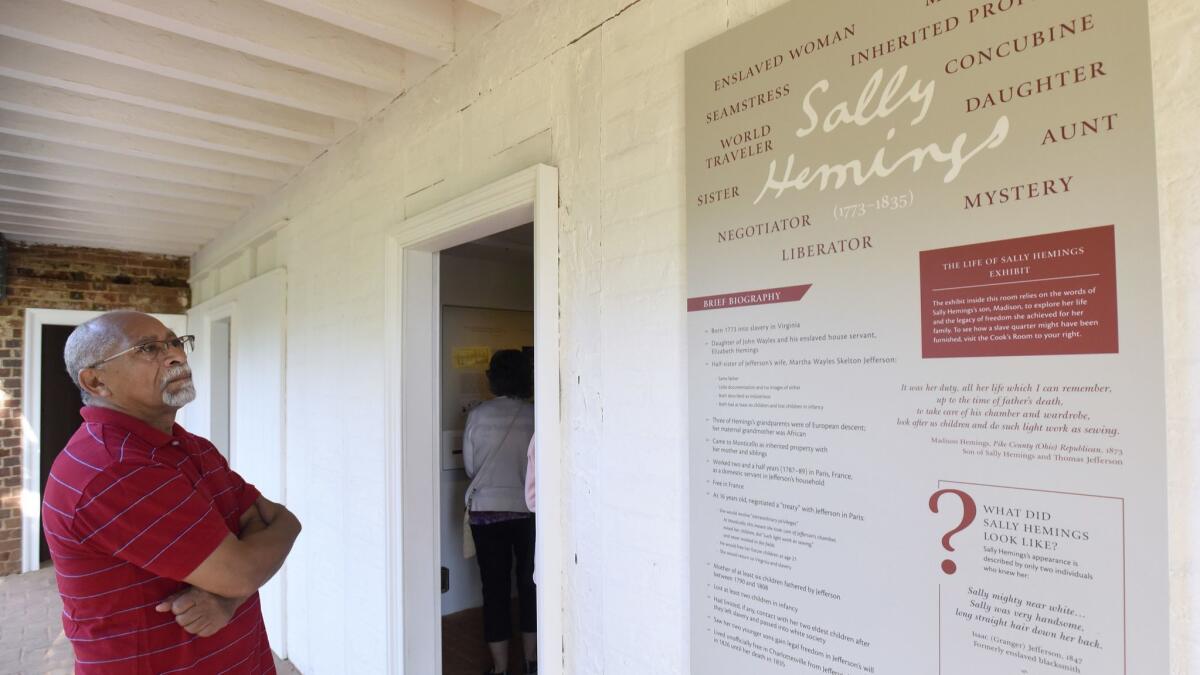Op-Ed: It’s time to recognize Sally Hemings as a first lady of the United States

- Share via
It is now widely understood that my ancestor Sally Hemings, an enslaved black woman, was the intimate companion of Thomas Jefferson for nearly four decades.
Monticello, the Virginia plantation operated as a museum by the Thomas Jefferson Foundation, acknowledged as much with a new exhibit last year: Hemings’ living quarters. The exhibit presents as fact that Hemings gave birth to at least six of Jefferson’s children.
Much about their relationship remains lost to history. We know that Hemings was Jefferson’s property, and that in America she did not have the right to refuse sexual advances from her owner. We also know that Hemings was able to negotiate freedom for her children and “extraordinary privileges” for herself, and that she occupied a central place in Jefferson’s life.
Hemings was with Jefferson from the late 1780s until his death in 1826.
Mainstream historians and the White House have long designated Martha Wayles Skelton Jefferson as our country’s third first lady. But Martha died in 1782, nearly two decades before Jefferson became president. Hemings was with Jefferson from the late 1780s until his death in 1826. And although she didn’t live at the White House, Hemings bore three of Jefferson’s children during the years when he was president.
For these reasons and others, it’s Sally Hemings, not Martha Wayles Skelton, who should be recognized as first lady.
This may seem a complex concept to wrap one’s mind around. But it is no more challenging than making sense of your lineage when your ancestors were enslaved.
Here’s what we know about my family.
In the 1730s, an English sea captain whose last name was Hemings conceived a child with an enslaved African woman. (Some historians speculate that the African woman’s name was Parthena.) The child, Elizabeth Hemings, became the property of a wealthy plantation owner named John Wayles.
John Wayles married three times. All three wives died relatively young, but not before bearing children. One of those children was Martha Wayles. After his third white wife died, John Wayles took as a “concubine” his black slave Elizabeth Hemings, also known as Betty. Wayles fathered six children with Betty: Robert, James, Thena, Critta, Peter and Sally.
(Yes, that’s correct: Sally Hemings, the enslaved woman who bore six of Thomas Jefferson’s children, was the half-sister of Martha Wayles Skelton, Jefferson’s white wife.)
Martha Wayles Skelton married her third cousin Thomas Jefferson in 1772, the year before Sally was born. Together, Martha and Thomas Jefferson had six children.
When John Wayles died, Jefferson inherited his property and slaves, including Sally, who then moved to Monticello as a toddler. After 10 years of marriage, Martha died. Only two of Martha’s children with Jefferson survived into adulthood: Martha “Patsy” Jefferson and Maria “Polly” Jefferson.
By the time Martha died, Jefferson had served in the Virginia House of Delegates and as governor of Virginia. He was elected to Congress the following year. The year after that, 1784, he moved to Paris, to serve first as a commissioner and then as U.S. minister to France.
Three years into what would be a five-year stay in Paris, Jefferson sent for his daughter Polly. (Patsy, the older of the two daughters, was already there.) Jefferson’s sister-in-law chose Sally, now 14 years old, to accompany Polly to France.
In Paris, Polly and Patsy lived mostly at a prestigious convent where they attended school, the Abbaye Royale de Panthemont. Sally lived at Jefferson’s residence, the Hotel De Langeac, and worked as a domestic servant and maid. It was during this period that Sally “became Mr. Jefferson’s concubine,” according to the published recollections of their future son Madison Hemings.
After two years, Jefferson was preparing to return to America. According to Madison’s account, Sally refused to return with him; in France, she was free. Sally agreed to return only after negotiating freedom for her future children and privileges for herself. (It is not known if Sally tried to negotiate for her own personal freedom.)
“In consequence of his promises,” as Madison put it, Sally returned to Virginia in 1789, pregnant with Jefferson’s child. The child “lived but a short time,” Madison said. Sally bore at least five more children with Jefferson, including Madison, who was named after future president James Madison at the request of his wife, Dolley.
Enter the Fray: First takes on the news of the minute from L.A. Times Opinion »
Jefferson never publicly acknowledged his relationship with Sally. But a political journalist, James T. Callender, exposed their relationship during Jefferson’s presidency in an article for a Richmond newspaper that was re-published widely, from Maine to Georgia. There is also evidence that John Adams may have gossiped about Jefferson and Hemings.
Jefferson freed Sally’s four surviving children, per their agreement. All four children were light-skinned, and three of them lived as members of white society as adults.
The Jefferson-Hemings line includes many notable figures. Madison’s grandson Frederick Madison Roberts, who was born in Ohio and grew up in Los Angeles, became the first black member of the California Legislature. He served 16 years.
After more than two centuries of willful collective ignorance about Jefferson and Hemings, it might sound far-fetched to suggest that she ought to be designated a first lady. But our country was populated through precisely this sort of racial mixing — sexual relationships that, it bears repeating, enslaved people such as Hemings did not choose for themselves.
It’s time we recognized Sally Hemings as the third first lady of the United States. Her story is the American story.
Evelia Jones is a direct descendant of Sally Hemings and Thomas Jefferson. Before retiring, she was a teacher in Los Angeles public schools for 34 years. Jones wrote this piece with Harvey Wasserman, a historian whose forthcoming book, “Life & Death Spiral of U.S. History,” will be published in April.
Follow the Opinion section on Twitter @latimesopinion or Facebook
More to Read
A cure for the common opinion
Get thought-provoking perspectives with our weekly newsletter.
You may occasionally receive promotional content from the Los Angeles Times.










